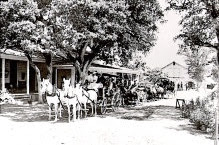Some place names just make you want to go there, and I didn't even mention "Poison Switch." We stopped there too. The original plan was to visit Ahwahnee Hills Regional Park which I read had some nice trails.
The Ahwahnee Tavern Stage Stop operated from 1893-1913. The building you see is not the original which burned down in 1937.
Here is a picture of the Tavern, circa 1900.
The tavern and ranch were sold in 1918 to create the Tri-County Tuberculosis Sanatorium, seen here. It operated from 1918-1969. Many buildings were added, including a hospital complex, quarters for doctors and nurses, a children's home, and a school. After the sanatorium closed in 1969, a School for Boys (with behavioral problems) operated until 1985. Most of the sanatorium buildings were torn down when the park was being developed. in the 1990s-2005.
"Ahwahnee" is an Indian word meaning "deep grassy valley," and of course the land was originally home for Native Miwok tribes. In 1851, a battle was fought here between the Miwok and a force of 74 Anglo miners.
The land was first homesteaded in 1882.
There are over 3 miles of wide walking trails, some of them wheelchair accessible. Additionally there is a more rugged hiking trail, and also horse trails.
Thistle and I toured the walking trails this day. The trail meanders through beautiful oak trees.
Part of the property is wetlands.
Mr. Great Blue Heron was keeping an eye on me.
Flowers were blooming on this pretty blue-sky day.
The lake has some waterfowl.
A pretty Bufflehead.
The small buildings are well houses.
Two Wild Turkeys were down by the lake.
Red-winged blackbird.
Western Kingbird
All the tiny holes are acorn storage for the Acorn Woodpeckers. Saw a lot of them, but no pictures. I wonder if the larger holes are for nesting?
I think these wildflowers are called Batchelor Buttons, but I was surprised to see one pink and the other blue.
Looking down the trail toward the lake. A really nice park.
Also in the town of Ahwahnee is the Wassama Roundhouse State Park.
This is a recreation of the original roundhouse(s).
Since I've been reading so much about Roosevelt's visit here by stagecoach, I decided to drive the old route to Raymond where he arrived by train. I had no idea what a treat that drive would be along Grub Gulch Road.
The first stop was at Gertrude School, built in 1878, remodeled in 1937, and closed in 1964. (The last 8th grader graduated in 1962) Today it houses an Art Gallery for Yosemite artists.
Not far down the road from Gertrude was the town of Poison Switch, a small cluster of buildings, including a saloon -- which apparently was the reason for the name. The name has been preserved as a spot on the flume which, for years, carried rough-cut lumber from Sugar Pine to Madera. A store opened there in 1897. A quarter-century later Andrew Mecchi bought the building and moved it to Ahwahnee for his store there. (A fact I did not know while I was in Ahwahnee, so I didn't get a picture of that old store.)
There is a trail down to the river where the old log flume was located.
Many gold mines were located near here, and there is still a mining claim in force...so don't get any ideas about panning here.
There is a sharp bend in the river.
Looking downriver toward the gulch.
Looking upriver and you can see a stream flowing from the left.
Thistle's looking for a place to get a drink without getting his feet wet.
The stream.
I couldn't find any pictures of Poison Switch, the town, but I did find this picture of the log flume that was here.
From there, Grub Gulch Road wends its way up into the mountains, yielding beautiful views of the snow-capped Sierras.
An historical monument is all that marks the location of the most populous town on the route, Grub Gulch, which boasted a population of 5,000. The town supported two hotels, two general stores, eight saloons, one mixed-grade school, a Chinese laundry and many homes scattered through the region....but no church. It served a variety of nearby mines, the most famous of which were the Gambetta and the Josephine hard-rock mines. The former is reputed to have yielded $15 million in gold.
Nothing remains of the town of Grub Gulch where Theodore Roosevelt is reputed to have spent the night in a hotel on his way to Yosemite.
The site of Grub Gulch.
Grub Gulch in its heyday.
He robbed 5 stages in succession, remaining on scene for over 2 hours. He even handed out his calling card. He was never apprehended.
A pretty wildflower growing here. I don't know the name.
Finally I arrived in Raymond where passengers to Yosemite disembarked the train to continue their journey by stagecoach. The Miller House is only open for tours on Sunday. It is the oldest house in Raymond.
But we're here to see where Theodore Roosevelt arrived in Raymond in 1903.
Of course, it's not the original train, but it is the original rail-bed and ties which are being preserved here:
If you come on Sunday, you can learn more inside:
This is a photo of Roosevelt on the train he rode west in 1903 on one of the many stops it made.
The Train Station at Raymond was known as Wild Cat Station.
Another historical building in Raymond, General Store, 1914.
So President Theodore Roosevelt got on a stagecoach similar to this one at Wild Cat Station.
And he rode over roads like this into Yosemite to meet with John Muir.
And we who enjoy our national parks can be thankful he had that foresight.

























































